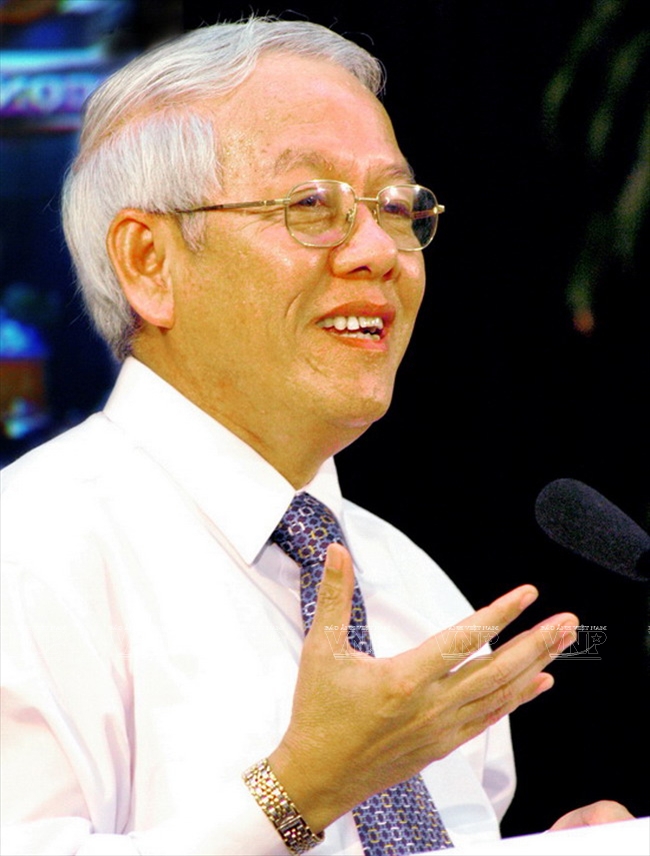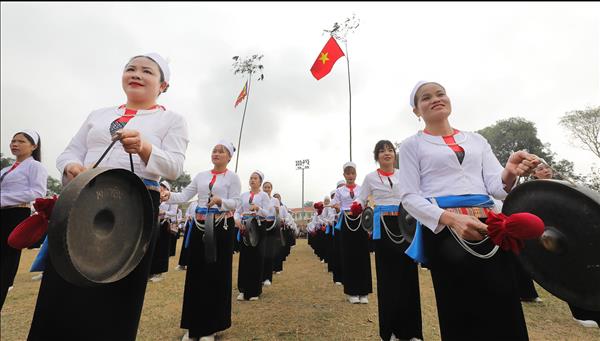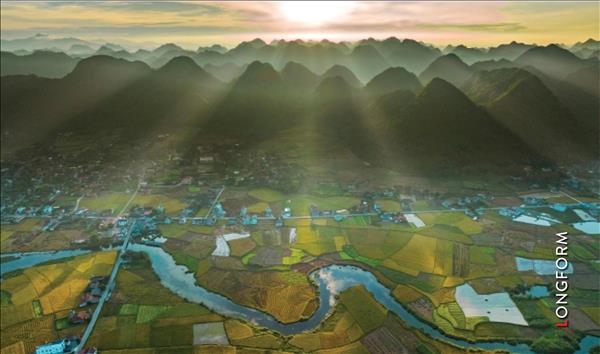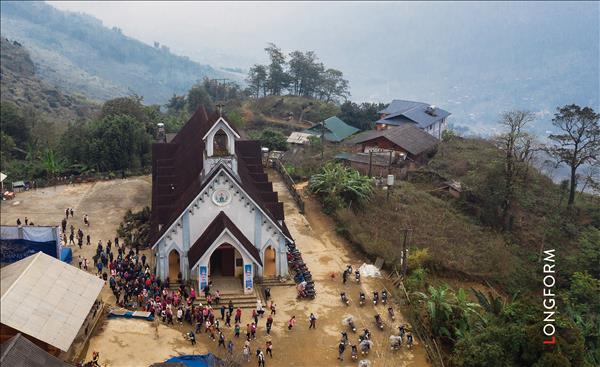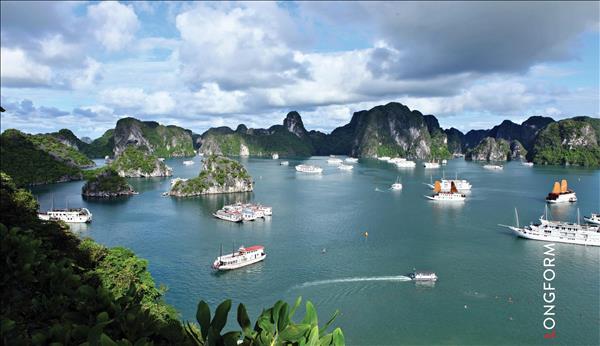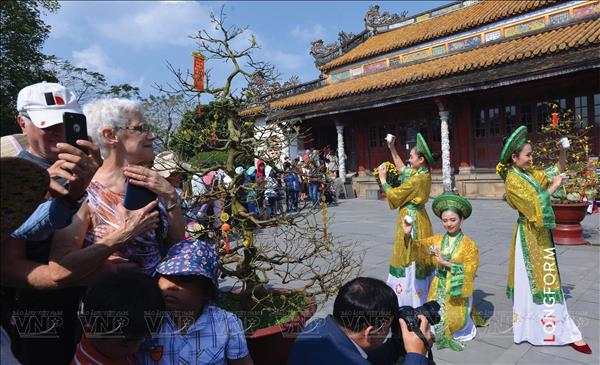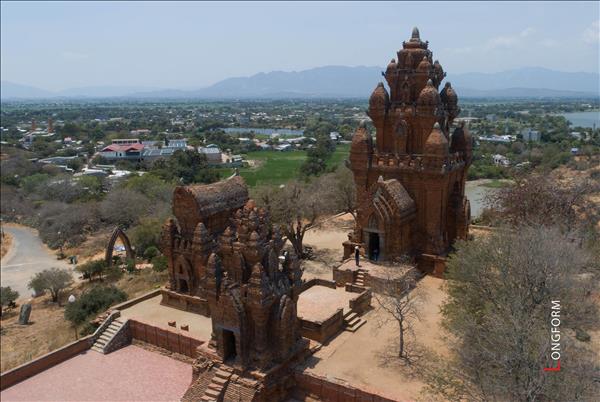A “megacity” on the banks of the Saigon River
Forty years ago, Saigon was dubbed the “Pearl of the Far East” because the US poured millions of dollars into this city to build an “empire” of indulgence to serve their huge war machine. However, few people knew that behind the glamour and sparkling colouful lights of the nightclubs, restaurants, hotels and dormitories, which were always crowded with the troops of the Republic of Vietnam and US advisors, a majority of people in Saigon still lived in the poor slums on the banks of the Saigon River and in the “black water hamlet” areas on the banks of the canals with foul smelling black water, garbage and mosquitoes. So, the rhetoric “Pearl of the Far East” seemed to be a distant dream for a majority of Saigon residents before 1975.
Forty years later, the story about the “Pearl of the Far East” seems to have receded into the past. Sometimes some people mention it but then it was quickly forgotten, because compared with Saigon in the past, Ho Chi Minh City of today is a “promised land”, a city worth living and working in with full of energy.
I met Dinh Viet Tu, an overseas Vietnamese from the United States, who returned to Vietnam to celebrate the 2015 New Year Festival. He was walking on Khanh Hoi Bridge connecting District 1 with District 4 and was contemplating the boats on the Saigon River and the magnificent high-rise buildings along the river banks.
Tu said with emotion: “I’ve been living away from Vietnam for 23 years and each time I return here I have an indescribable feeling. Saigon has changed so fast! The city today is so modern and large!”.
To prove his words, he mentioned some modern places he had visited while walking around the city, such as Thu Thiem Tunnel, Phu My Bridge, Vo Van Kiet Avenue, Pham Van Dong Avenue, Ho Chi Minh – Trung Luong Expressway and Phu My Hung Urban Area.
While talking with him, I happened to remember some recent statistics of the United Nations. According to these statistics, immigrants account for one third of the population of Ho Chi Minh City and this number will continue to increase. Experts also predicted that, by 2020 Ho Chi Minh City will be a “megacity” with a population of about 10 million people. Therefore, the plan to develop the city into a modern one with a wide vision is now the number one priority of the authorities.
In recent years, the city’s architectural infrastructure has experienced unprecedentedly rapid changes. The swamps and canals with foul smelling black water in the past have become new-styled and modern urban areas, such as Phu My Hung, Thu Thiem, Dai Quang Minh and Nhieu Loc – Thi Nghe Urban Areas. In 1997, the American Institute of Architects selected the master plan of Phu My Hung new urban area as the best in Asia.
Besides the urban areas, the transportation infrastructure has also been expanded. Many modern roads, such as Truong Sa and Hoang Sa Roads, Vo Van Kiet, Pham Van Dong and Nguyen Van Linh Avenues, Ho Chi Minh – Trung Luong Expressway, Ho Chi Minh – Long Thanh – Dau Giay Expressway, Thu Thiem Tunnel and Ben Thanh – Suoi Tien Metro have been built, creating a transportation system connecting the inner city with the surrounding areas as well as with the southeast, southwest and Tay Nguyen (the Central Highlands).
Another great success of Ho Chi Minh City is the creation of harmony between the old and new landscape architecture. Now, Saigon is 317 years old and Ho Chi Minh City is turning 40 with great changes in its urban appearance. However, it still retains many architectural heritage spots associated with the history of establishment and development of the city, such as Notre Dame Cathedral (built in 1877), Saigon Post Office (1891), Opera House (1900), Hotel de Ville de Saigon – now Ho Chi Minh City People’s Committee (1907) and Ben Thanh Market (1914). These create a harmonious feature of a modern and dynamic city with intact historical values.
Being a “leading” city of the southern region and a big economic centre of the country, Ho Chi Minh City has not only focused on developing the transportation infrastructure and new urban areas, but has also invested in developing the export processing zones (EPZs) and industrial zones (IZs) to attract investment for economic development.
Ho Chi Minh City has successfully built 15 EPZs and IZs with a total area of 2,500ha in nine districts. They not only attracted foreign investment quickly but also created jobs for hundreds of thousands of local people, contributing to the economic development of the city in the direction of industrialisation and modernisation and creating an important premise for the urbanisation of the surrounding areas.
Vitality of a young city
Immediately after liberation on April 30, 1975, one of the important tasks of the Ho Chi Minh City authorities was to stabilise and improve the life of the people. In recent years, with the rapid development of the urban infrastructure, the economic, cultural and social life of the people have constantly improved and leads the country.
With the slogan “civilisation, modernity and sentimental attachment”, Ho Chi Minh City attaches importance to caring for and improving the life of the people, using practical and effective solutions, such as developing the social insurance system; implementing universal health insurance; promoting poverty reduction programmes to help narrow the gap between the strata and groups of population in society and between the urban and rural areas; gradually raising the standards of social security of the city to the level of the rest of Southeast Asia and the world.
The slogan “civilisation and sentimental attachment” is also reflected in many diverse and interesting cultural and tourist activities which attract a large number of local people and foreigners to participate in. These activities include the artistic programmes to welcome the New Year, street festivals, Ho Chi Minh City tourism festival and culinary festivals. There are also traditional cultural festivals, such as the Nguyen Tieu Festival and Lady Thien Hau Pagoda Festival. These activities not only improve the cultural life of the residents but also introduce international friends to the culture of the residents.
As usual, on the first day of the New Year, the tourism sector of Ho Chi Minh City organises a welcoming ceremony for the first group of foreign visitors to the city with a traditional repertoire in a cheerful and warm atmosphere.
Jack Kelly, a British visitor said: “I am very impressed with the climate and residents of Ho Chi Minh City, so this is the second time I have brought my family to the city for sightseeing and relaxation. Indeed, the landscape, especially the history of this land has many interesting things for us to explore”.
Reportedly, in 2014 the city received 4.5 million international visitors, accounting for 55% of the total number of international visitors to Vietnam. During the 2015 New Year Festival, millions of tourists and people flocked to Ho Chi Minh City to visit the well-known tourist sites, such as Suoi Tien Amusement Park, Dam Sen, Saigon Zoo and Botanical Gardens, Ham Nghi Flower Street and the spring flower festival at Tao Dan Park.
In 2014, along with 20 other cities in the South, Ho Chi Minh City had the honour to receive a certificate of UNESCO’s recognition of Don ca tai tu, an art form of southern culture, as a world’s cultural heritage. It may be said that Saigon – Ho Chi Minh City is one of the cradles of this unique folk music. In the progress of the era and the strong cultural integration, the city residents with their internal strength and their love for the country still retain their own cultural identity. If you have an opportunity to visit and go to the outskirts of the city, such as Can Gio, Binh Chanh, Nha Be, Hoc Mon and Cu Chi, you can see the pervasion of this special art form in the life of the people. Perhaps, it creates the liberal, friendly and hospitable culture of the people in Ho Chi Minh City in particular and in the South in general.
Regarding the economic life, in 2002 Ho Chi Minh City was the first locality in the country to implement a price stabilisation programme. Thanks to this programme, the market prices are always stable, making a great contribution to ensuring the life of the people. The typical enterprises which actively participate in the programme include Saigon Co-op, Ba Huan, Vissan Saigon Agriculture Incorporation and San Ha Company. To enhance the effectiveness of the programme, the city has implemented many projects, such as developing animal husbandry to create a stable resource of products; developing the wholesale and retail systems; implementing the campaign “Vietnamese people use Vietnamese goods”; promoting trade cooperation with the southern provinces to create favourable conditions for the enterprises to coordinate in supplying goods, consuming the products and expanding the market.
Now, in addition to 9,000 price stabilisation stores selling over 350 categories of products, Ho Chi Minh City has organised over 1,000 mobile sale trips to remote areas, EPZs and IZs to timely meet the needs of the poor working people.
Ho Chi Minh City is the most populous city in the country, so the city authorities pay great attention to housing. To ensure the best living conditions for people, especially low-income people, the authorities have built a lot of low cost houses and apartments, using the domestic sources of capital and international assistance. Currently, the city has 62 projects with nearly 70,000 apartments to rent and sell to workers and employees. Of these projects there are 14 housing projects with about 10,000 apartments for workers and 46 housing projects with 8,000 apartments for employees; the remaining projects are on building dormitories for students and resettlement houses.
It can be said that after 40 years, from being the “Pearl of the Far East”, Ho Chi Minh City – the windy and sunny land in the rich, beautiful and hospitable southern region, is becoming a modern “megacity” with a firm economic, cultural and social foundation and is developing on a par with the region and the world.
Forty years ago, Saigon was dubbed the “Pearl of the Far East” because the US poured millions of dollars into this city to build an “empire” of indulgence to serve their huge war machine. However, few people knew that behind the glamour and sparkling colouful lights of the nightclubs, restaurants, hotels and dormitories, which were always crowded with the troops of the Republic of Vietnam and US advisors, a majority of people in Saigon still lived in the poor slums on the banks of the Saigon River and in the “black water hamlet” areas on the banks of the canals with foul smelling black water, garbage and mosquitoes. So, the rhetoric “Pearl of the Far East” seemed to be a distant dream for a majority of Saigon residents before 1975.
Forty years later, the story about the “Pearl of the Far East” seems to have receded into the past. Sometimes some people mention it but then it was quickly forgotten, because compared with Saigon in the past, Ho Chi Minh City of today is a “promised land”, a city worth living and working in with full of energy.
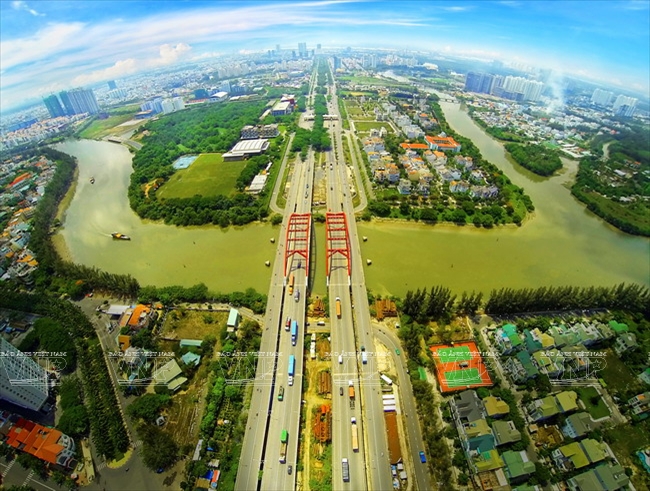 After forty years, Ho Chi Minh City has developed into a “Megacity” of regional stature. Photo: Nguyen Minh Tan 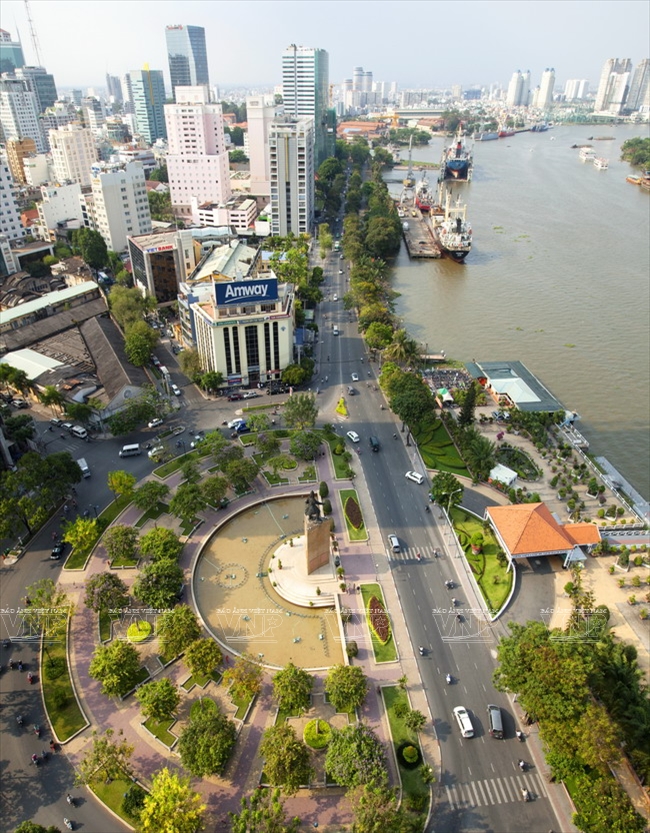 Forty years after the country was reunited, Ho Chi Minh City has developed dynamically with a harmonious feature of a modern and dynamic city with intact historical values. Photo: Dang Kim Phuong/VNP 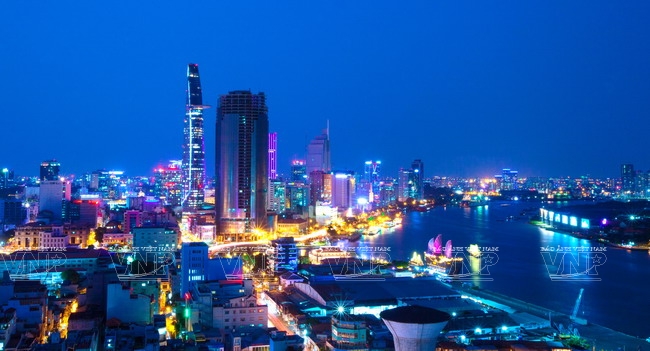 Ho Chi Minh City has drastically changed with modern architectural structures on the banks of the Saigon River. Photo: Le Minh/VNP 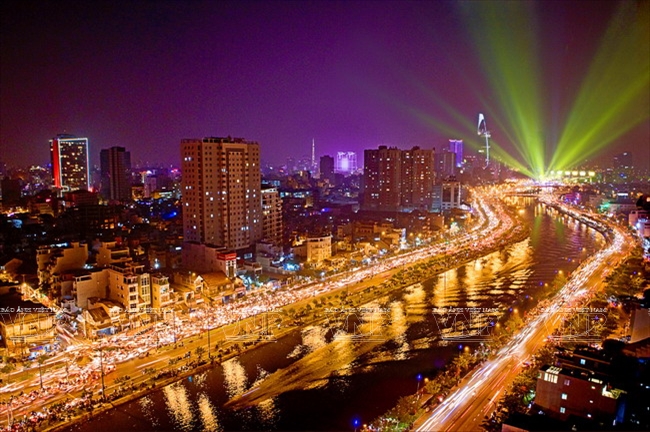 A series of new-styled and modern urban areas have been built in the areas of swamps and canals where the foul smelling black water flowed in the past. Photo: Kim Chi  The Canal lit by lights. Photo: Kim Chi 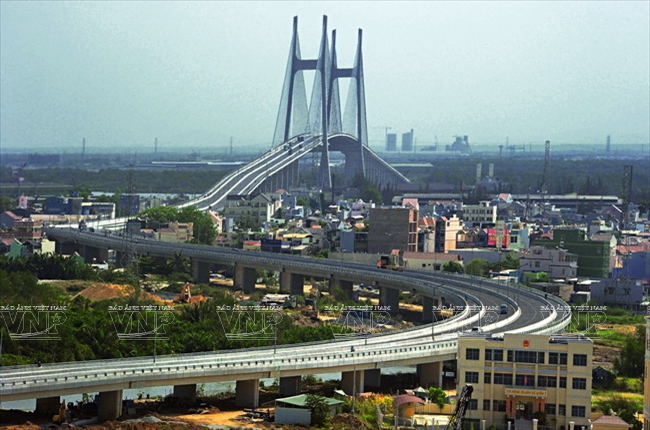 The transportation infrastructure system has been upgraded and expanded with avenues, expressways, highways, bridges and tunnels, forming an interconnected system that connects the inner city with the surrounding areas. Photo: Dang Kim Phuong/VNP 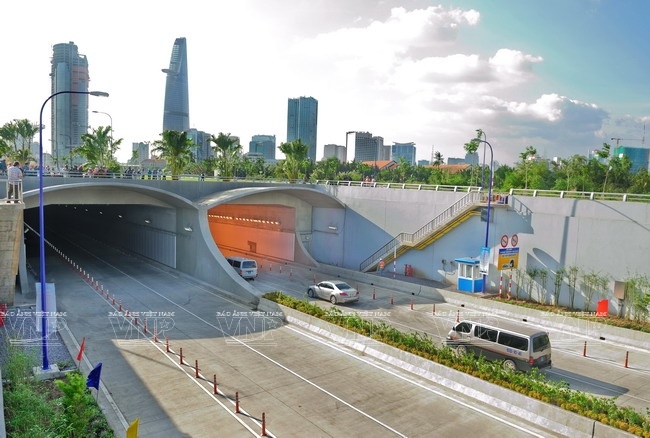 Thu Thiem Tunnel, which has been open since November, 2011, is now one of the most modern transportation works in Southeast Asia. Photo: Nguyen Luan/VNP 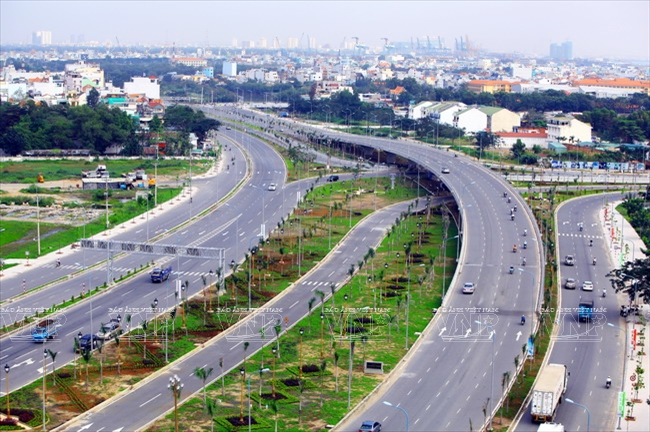 The plan to develop Ho Chi Minh City into a modern city with a wide vision is now the number one priority of the authorities. Photo: Nguyen Thang/VNP 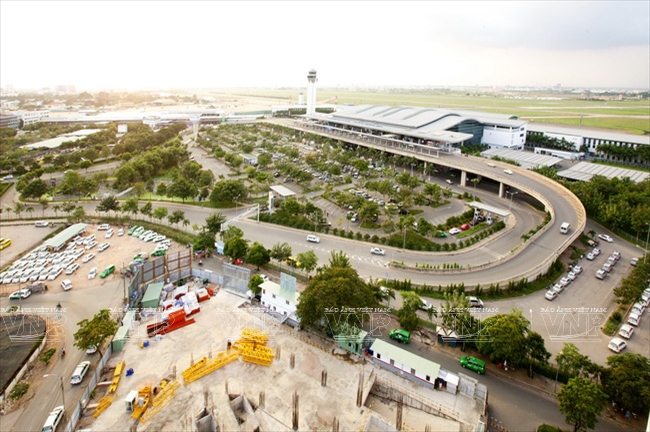 Part of Tan Son Nhat International Airport. Photo: Dang Kim Phuong/VNP |
|
Tu said with emotion: “I’ve been living away from Vietnam for 23 years and each time I return here I have an indescribable feeling. Saigon has changed so fast! The city today is so modern and large!”.
To prove his words, he mentioned some modern places he had visited while walking around the city, such as Thu Thiem Tunnel, Phu My Bridge, Vo Van Kiet Avenue, Pham Van Dong Avenue, Ho Chi Minh – Trung Luong Expressway and Phu My Hung Urban Area.
While talking with him, I happened to remember some recent statistics of the United Nations. According to these statistics, immigrants account for one third of the population of Ho Chi Minh City and this number will continue to increase. Experts also predicted that, by 2020 Ho Chi Minh City will be a “megacity” with a population of about 10 million people. Therefore, the plan to develop the city into a modern one with a wide vision is now the number one priority of the authorities.
In recent years, the city’s architectural infrastructure has experienced unprecedentedly rapid changes. The swamps and canals with foul smelling black water in the past have become new-styled and modern urban areas, such as Phu My Hung, Thu Thiem, Dai Quang Minh and Nhieu Loc – Thi Nghe Urban Areas. In 1997, the American Institute of Architects selected the master plan of Phu My Hung new urban area as the best in Asia.
Besides the urban areas, the transportation infrastructure has also been expanded. Many modern roads, such as Truong Sa and Hoang Sa Roads, Vo Van Kiet, Pham Van Dong and Nguyen Van Linh Avenues, Ho Chi Minh – Trung Luong Expressway, Ho Chi Minh – Long Thanh – Dau Giay Expressway, Thu Thiem Tunnel and Ben Thanh – Suoi Tien Metro have been built, creating a transportation system connecting the inner city with the surrounding areas as well as with the southeast, southwest and Tay Nguyen (the Central Highlands).
Another great success of Ho Chi Minh City is the creation of harmony between the old and new landscape architecture. Now, Saigon is 317 years old and Ho Chi Minh City is turning 40 with great changes in its urban appearance. However, it still retains many architectural heritage spots associated with the history of establishment and development of the city, such as Notre Dame Cathedral (built in 1877), Saigon Post Office (1891), Opera House (1900), Hotel de Ville de Saigon – now Ho Chi Minh City People’s Committee (1907) and Ben Thanh Market (1914). These create a harmonious feature of a modern and dynamic city with intact historical values.
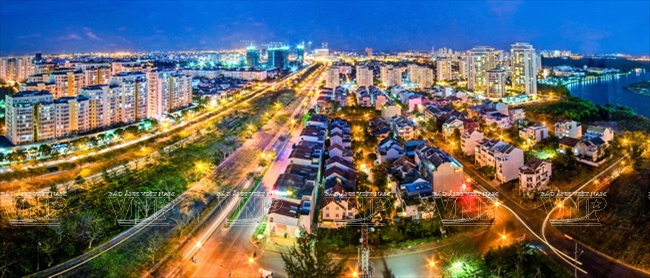 The city has attracted more projects on building modern urban areas that help improve the living conditions of millions of residents. Photo: Kim Chi 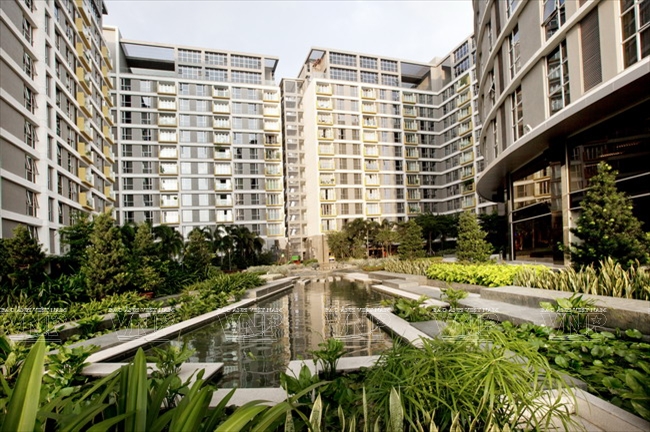 Saigon Pearl Project – a residential complex in the northeast of Ho Chi Minh City. Photo: Dang Kim Phuong/VNP  Saigon Pearl Project – a residential complex in the northeast of Ho Chi Minh City. Photo: Dang Kim Phuong/VNP 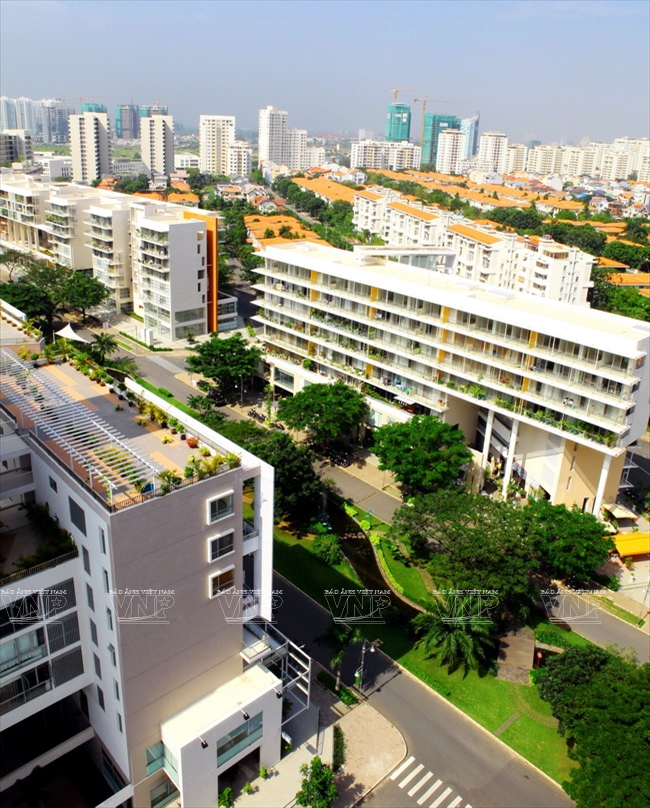 A corner of Phu My Hung Urban Area which was selected as the best plan in Asia by the American Institute of Architects in 1997. Photo: Nguyen Thang/VNP |
| Under a plan from now until 2050, Ho Chi Minh City will develop in four directions: north, east, west and south. Some new urban areas have been built, such as South Saigon (in District 7), Thu Thiem (District 2), Tay Bac (Cu Chi District), Hiep Phuoc, Phuoc Kieng (Nha Be District), Sinh Viet (Binh Chanh District) and An Phu Hung (Hoc Mon District). |
Ho Chi Minh City has successfully built 15 EPZs and IZs with a total area of 2,500ha in nine districts. They not only attracted foreign investment quickly but also created jobs for hundreds of thousands of local people, contributing to the economic development of the city in the direction of industrialisation and modernisation and creating an important premise for the urbanisation of the surrounding areas.
Vitality of a young city
Immediately after liberation on April 30, 1975, one of the important tasks of the Ho Chi Minh City authorities was to stabilise and improve the life of the people. In recent years, with the rapid development of the urban infrastructure, the economic, cultural and social life of the people have constantly improved and leads the country.
With the slogan “civilisation, modernity and sentimental attachment”, Ho Chi Minh City attaches importance to caring for and improving the life of the people, using practical and effective solutions, such as developing the social insurance system; implementing universal health insurance; promoting poverty reduction programmes to help narrow the gap between the strata and groups of population in society and between the urban and rural areas; gradually raising the standards of social security of the city to the level of the rest of Southeast Asia and the world.
The slogan “civilisation and sentimental attachment” is also reflected in many diverse and interesting cultural and tourist activities which attract a large number of local people and foreigners to participate in. These activities include the artistic programmes to welcome the New Year, street festivals, Ho Chi Minh City tourism festival and culinary festivals. There are also traditional cultural festivals, such as the Nguyen Tieu Festival and Lady Thien Hau Pagoda Festival. These activities not only improve the cultural life of the residents but also introduce international friends to the culture of the residents.
As usual, on the first day of the New Year, the tourism sector of Ho Chi Minh City organises a welcoming ceremony for the first group of foreign visitors to the city with a traditional repertoire in a cheerful and warm atmosphere.
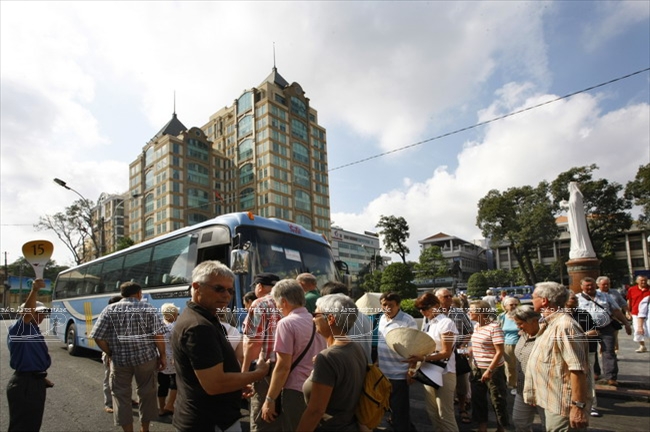 Each year, Ho Chi Minh City receives 4.5 million international visitors, accounting for 55% of the total number of international visitors to Vietnam. Photo: VNP’s File  International visitors visit Reunification Palace, the headquarters of the Saigon Government before 1975. Photo: Nguyen Luan/VNP 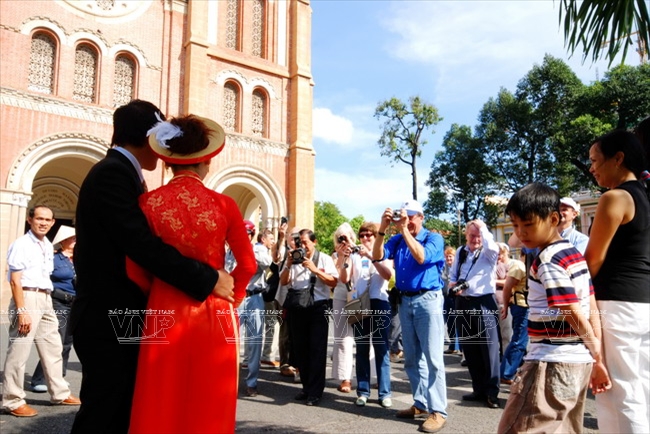 A young couple takes wedding photos in front of Notre Dame Cathedral. Photo: VNP’s File 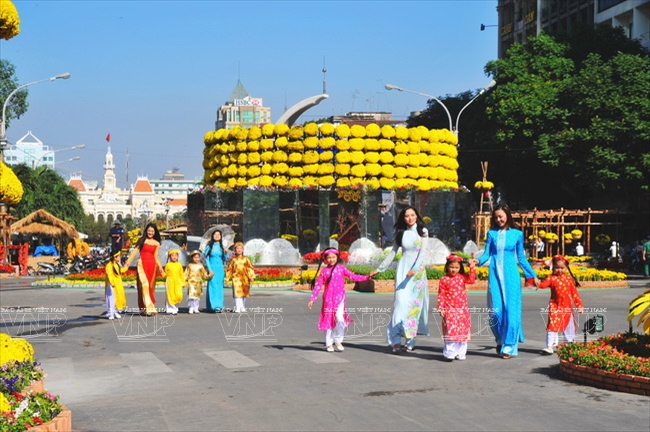 Nowadays, Ho Chi Minh City is a megacity and ready to integrate deeply into the world. Photo: VNP’s File 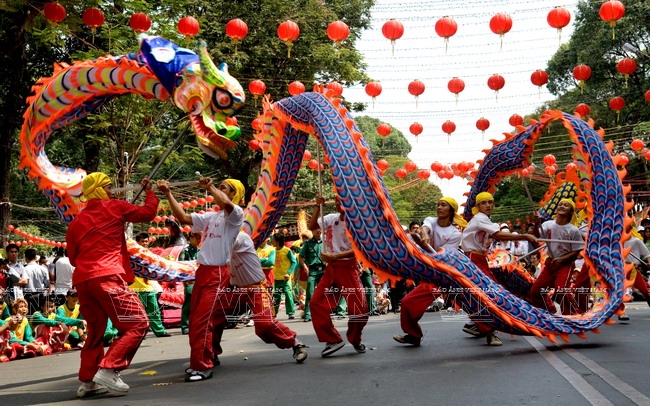 Dragon dance performing on Ho Chi Minh City’s street. Photo: VNP’s File 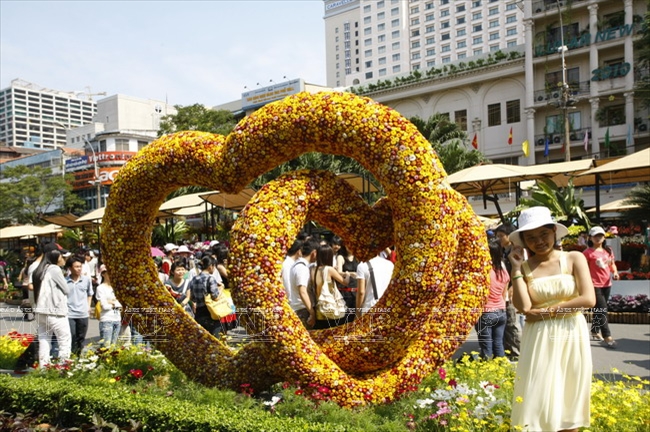 Nguyen Hue Flower Road in spring. Photo: VNP’s File 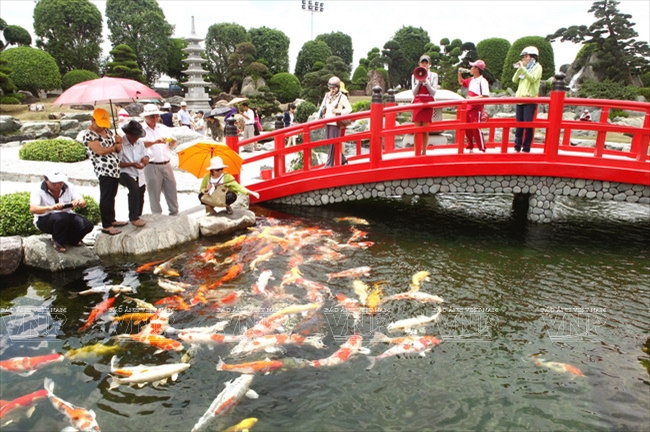 The Japanese Cultural Park in Ho Chi Minh City. Photo: Le Minh/VNP 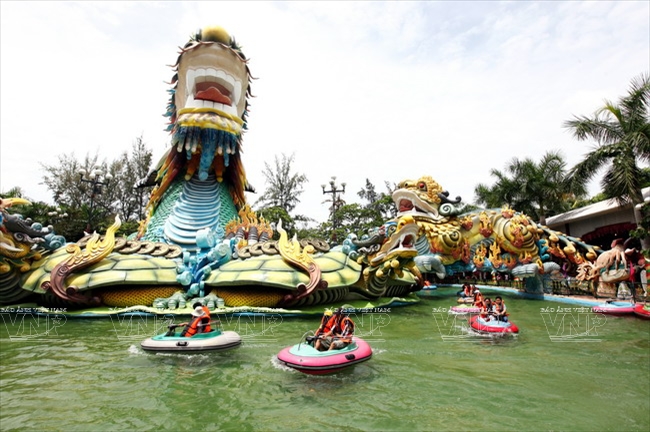 Suoi Tien Tourism Complex attracts both domestic and foreign tourists. Photo: Le Minh/VNP 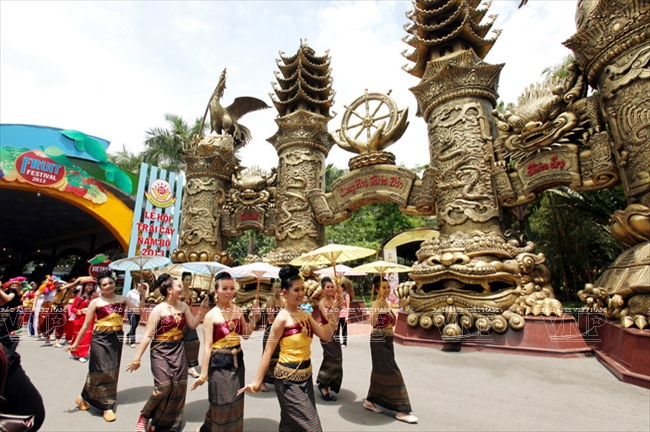 Performing a traditional art programme at the Fruit Festival which is annually held at Suoi Tien Tourism Complex. Photo: Le Minh/VNP |
Jack Kelly, a British visitor said: “I am very impressed with the climate and residents of Ho Chi Minh City, so this is the second time I have brought my family to the city for sightseeing and relaxation. Indeed, the landscape, especially the history of this land has many interesting things for us to explore”.
Reportedly, in 2014 the city received 4.5 million international visitors, accounting for 55% of the total number of international visitors to Vietnam. During the 2015 New Year Festival, millions of tourists and people flocked to Ho Chi Minh City to visit the well-known tourist sites, such as Suoi Tien Amusement Park, Dam Sen, Saigon Zoo and Botanical Gardens, Ham Nghi Flower Street and the spring flower festival at Tao Dan Park.
In 2014, along with 20 other cities in the South, Ho Chi Minh City had the honour to receive a certificate of UNESCO’s recognition of Don ca tai tu, an art form of southern culture, as a world’s cultural heritage. It may be said that Saigon – Ho Chi Minh City is one of the cradles of this unique folk music. In the progress of the era and the strong cultural integration, the city residents with their internal strength and their love for the country still retain their own cultural identity. If you have an opportunity to visit and go to the outskirts of the city, such as Can Gio, Binh Chanh, Nha Be, Hoc Mon and Cu Chi, you can see the pervasion of this special art form in the life of the people. Perhaps, it creates the liberal, friendly and hospitable culture of the people in Ho Chi Minh City in particular and in the South in general.
Regarding the economic life, in 2002 Ho Chi Minh City was the first locality in the country to implement a price stabilisation programme. Thanks to this programme, the market prices are always stable, making a great contribution to ensuring the life of the people. The typical enterprises which actively participate in the programme include Saigon Co-op, Ba Huan, Vissan Saigon Agriculture Incorporation and San Ha Company. To enhance the effectiveness of the programme, the city has implemented many projects, such as developing animal husbandry to create a stable resource of products; developing the wholesale and retail systems; implementing the campaign “Vietnamese people use Vietnamese goods”; promoting trade cooperation with the southern provinces to create favourable conditions for the enterprises to coordinate in supplying goods, consuming the products and expanding the market.
Now, in addition to 9,000 price stabilisation stores selling over 350 categories of products, Ho Chi Minh City has organised over 1,000 mobile sale trips to remote areas, EPZs and IZs to timely meet the needs of the poor working people.
 Inside Robins - a high quality shopping mall in the city. Photo: Le Minh/VNP 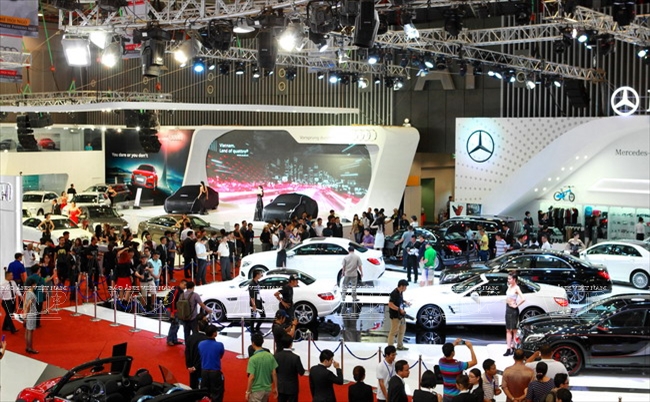 Vietnam Motorshow, one of the annual reputable events in Ho Chi Minh City, attracts the participation of famous car brands around the world. Photo: Nguyen Luan/VNP  The wharf system in Ho Chi Minh City has been further developed. Photo: Dang Kim Phuong/VNP  The major garment companies in the city, such as Nha Be Garment Corporation, have produced high-grade product lines, such as suits and shirts which have a strength in competitiveness in international markets. Photo: Dang Kim Phuong/VNP 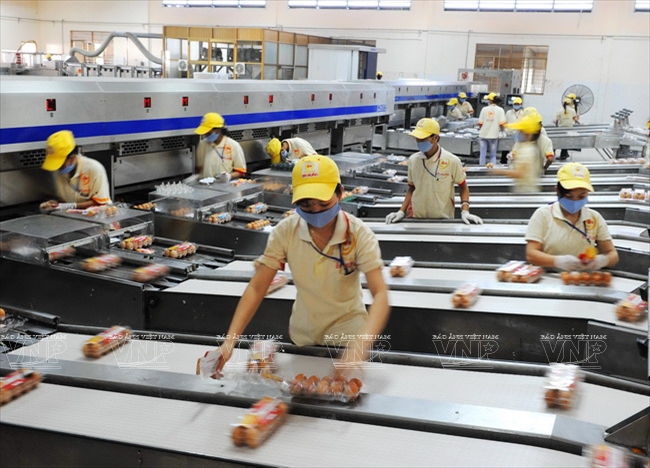 The workshop of producing safe and clean eggs of Ba Huan Company Ltd in Ho Chi Minh City. Photo: Dang Kim Phuong/VNP |
| In 2014, the city’s GDP accounted for over 20% of the national GDP; its revenues and export turnover accounted for 30% of the country; the per capita income was 5,131 dollars/person and is expected to reach 5,826 dollars/person by the end of 2015. |
It can be said that after 40 years, from being the “Pearl of the Far East”, Ho Chi Minh City – the windy and sunny land in the rich, beautiful and hospitable southern region, is becoming a modern “megacity” with a firm economic, cultural and social foundation and is developing on a par with the region and the world.
Story: Nguyen Vu Thanh Dat, Nguyen Oanh
Photos: Nguyen Thang, Le Minh, Dang Kim Phuong,
Nguyen Luan, nguyen minh tan, kim chi & VNP’s files
Photos: Nguyen Thang, Le Minh, Dang Kim Phuong,
Nguyen Luan, nguyen minh tan, kim chi & VNP’s files
phamtrangnhung

